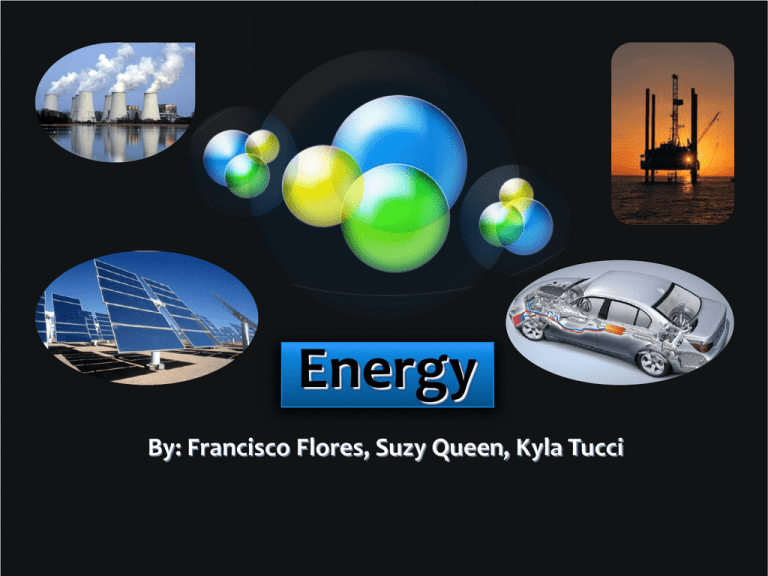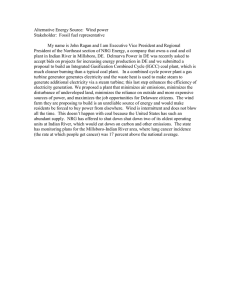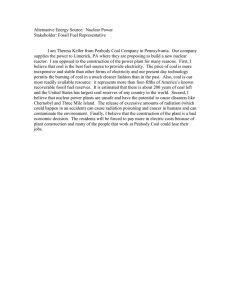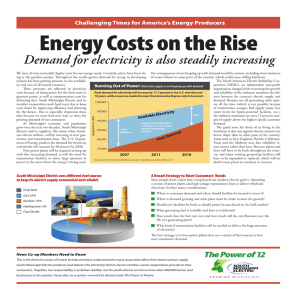Energy By: Francisco Flores, Suzy Queen, Kyla Tucci
advertisement

Energy By: Francisco Flores, Suzy Queen, Kyla Tucci Canada’s Energy Use Today Uses a great deal of energy for transportation Industrial economy uses a large amount of energy Energy is cheap in Canada Energy is divided into 2 categories: Conventional energy sources: oil, natural gas, hydroelectricity, and nuclear electricity Alternative energy sources: solar, wind, biomass energy Energy Terminology The metric unit used to measure energy: “Joule” (J)-Tiny amount of energy 1 Gigajoule (GJ) = 1 billion Joules (J) 1 Petajoule (PJ) = 1 billion Gigajoules Formation of Coal Deposits Formed from the remains of trees and plants that grew in swampy 300-600 million years ago Layer upon layer of undecayed vegetation formed deep deposits of organic matter Different amounts of compression formed different types of coal Anthracite coal- formed under great pressure; hard Bituminous Coal-formed under less pressure; softer Canada’s Coal Industry Used primarily for fuel in the generation of electricity In 2004, 93% of coal consumed in Canada was used in electrical power generation Remaining 7% went to steel plants in Ont. & Quebec Creation of Oil and Gas Millions of years ago Seas were covered by shallow oceans Immense weight of layers compressed lower layers into sedimentary rock Bacteria; heat & pressure- converted remains of animals and plants into oil and gas Oil and gas are found in geological structures. They act as traps; preventing oil and gas from rising to the surface Characteristics: • • Layer of porous rock Upper & lower layers of nonporous rock; form traps for oil and gas Recovering oil and Gas Flowing wells- controlled by a series of valves called a “Christmas tree” Non-flowing wells- run on electric/gas powered pumps Secondary Recovery- As oil is removed from a deposit, the recovery of the soil that remains becomes more difficult. Scientists have created a variety of methods to remove more of the remaining oil from deposits, increasing the total percentage taken from deposits. Sources of Canada’s oil and gas Boreal plains and prairie Ecozones Production concentrated in Alberta Adjoining parts of: Saskatchewan British Columbia Northwest Territories Electricity Produced by generators Generator can range from size of holding it in your hand (bicycle light) to the size of 1 large house (power station) They work the same – converts mechanical energy into electrical energy With the bicycle light, the turning of the wheel provides the mechanical energy With the power station, rotating turbines provide the mechanical energy Power companies in Canada make huge amounts of electricity as cheap as possible by using any 3 methods to turn turbines that supply mechanical energy to generators; Moving water in a hydroelectric generating station Expanding steam is produced by burning coal, oil, or natural gas in a thermal-electric generating station Expanding steam produced from nuclear fusion in a nuclearelectric generating station Thermoelectricity Steam, rather than moving water, turns the turbines Steam produced by burning fuel such as; coal, oil, natural gas, wood & even garbage Advantages Plants can be built near population centers where the electricity is needed. This means shorter transmission lines built, keeping the cost of transmission relatively low. Plants built near where fuel is already available. If cost of transporting fuel is lower, cost of producing energy will be lower. Plants are less expensive to build than hydro or hydro or nuclear – electric plants. Disadvantages Fuel costs-especially for oil and natural gas- are high and are increasing rapidly Oil, natural gas and coal are nonrenewable resources and will run out eventually Coal burning thermal-electric plants produce a lot of pollution and the burning of 3 fuels contributes to global warming. Coal and oil produce the gases that are responsible for acid precipitation. Electrical production in Canada Wide variation in the kind of electrical generation used in different parts of Canada Ontario uses large amounts of electricity generated by all types of plants, including Canada’s only large nuclear plants No longer any large undeveloped hydroelectric sites in the provinces Future increases in demand will have to be by building thermal-electric or nuclear-electric plants, importing energy from other provinces or developing other energy sources such as wind power.








